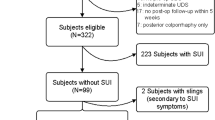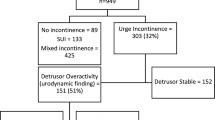Abstract
Purpose
To investigate Occult Stress Urinary Incontinence (OSUI) using physical exam (PE) and urodynamics (UDS) in women with advanced pelvic organ prolapse (POP), and compare the two methods.
Methods
This study comprised 105 women with POP stage-III and -IV, according to POP quantification (POP-Q) system, evaluated prospectively between January and December 2015. A standard history, an incontinence questionnaire and PE were completed before the investigation of the OSUI that was performed in the supine and standing positions, reducing the prolapse using gauze and Cheron dressing forceps. The stress test was performed with and without the prolapse reduction.
Results
The mean patient age was 65.7 years, mean parity 5.1 and mean body mass index 27.4. From a total of 105 patients, 70 (66.7%) presented with POP-Q stage III and 35 (33.3%) stage IV. Sixty-three (60%) women were identified as having OSUI, 27 (25.7%) as continent, and 15 (14.3%) having stress urinary incontinence. From the 63 OSUI subjects, 48 (76.2%) were identified in both evaluations, eight were identified only during PE, and seven only during UDS. The sensitivity to detect OSUI during PE and UDS was 88.9 and 87.3%, respectively (P = .783). The kappa value to measure the agreement between both tests was .648 (95% CI .441–.854).
Conclusion
UDS and PE are equivalent and concordant to demonstrate OSUI, thus it is not necessary to perform UDS to exclusively identify OSUI. UDS utility in OSUI patients, to evaluate urethral and detrusor function, deserves further investigation.
Similar content being viewed by others
References
Rosenzweig BA, Pushkin S, Blumenfeld D, Bhatia NN (1992) Prevalence of abnormal urodynamic test results in continent women with severe genitourinary prolapse. Obstet Gynecol 79(4):539–542
Petros PEP (2010) The integral theory system. A simplified clinical approach with illustrative case histories. Pelviperineology 29:37–51
Haylen BT, de Ridder D, Freeman RM, Swift SE, Berghmans B, Lee J, Monga A, Petri E, Rizk DE, Sand PK, Schaer GN (2010) An International Urogynecological Association (IUGA)/International Continence Society (ICS) joint report on the terminology for female pelvic floor dysfunction. Neurourol Urodyn 29:5–26
Richardson DA, Bent AE, Ostergard DR (1983) The effect of uterovaginal prolapse on urethrovesical pressure dynamics. Am J Obstet Gynecol 146:901–905
Visco AG, Brubaker L, Nygaard I, Richter HE, Cundiff G, Fine P, Zyczynski H, Brown MB, Weber AM (2008) The role of preoperative urodynamic testing in stress-continent women undergoing sacrocolpopexy. The Colpopexy and Urinary Reduction Efforts (CARE) randomized surgical trial. Int Urogynecol J 19:607–614
Wei JT, Nygaard I, Richter HE, Nager CW, Barber MD, Kenton K, Amundsen CL, Schaffer J, Meikle SF, Spino C, Pelvic Floor Disorders Network (2012) A midurethral sling to reduce incontinence after vaginal prolapse repair. N Engl J Med 366:2358–2367
Glazener CM, Lapitan MC (2012) Urodynamic studies for management of urinary incontinence in children and adults. Cochrane Database Syst Rev 18(1):CD003195
Sirls LT, Richter HE, Litman HJ, Kenton K, Lemack GE, Lukacz ES, Kraus SR, Goldman HB, Weidner A, Rickey L, Norton P, Zyczynski HM, Kusek JW, Urinary Incontinence Treatment Network (2013) The effect of urodynamic testing on clinical diagnosis, treatment plan and outcomes in women undergoing stress urinary incontinence surgery. J Urol 189:204–209
Okorocha I, Cumming G, Gould I (2002) Female urodynamics and lower urinary tract infection. BJU Int 89:863–867
Roovers JP, Oelke M (2007) Clinical relevance of urodynamic investigation tests prior to surgical correction of genital prolapse: a literature review. Int Urogynecol J 18:455–457
Bump RC, Mattiasson A, Bø K, Brubaker LP, DeLancey JO, Klarskov P, Shull BL, Smith AR (1996) The standardization of terminology of female pelvic organ prolapse and pelvic floor dysfunction. Am J Obstet Gynecol 175:10–17
Tamanini JTN, Dambros M, D´Ancona CAL, Palma PCR, Netto NR Jr (2004) Validation of the “International Consultation on Incontinence Questionnaire—Short Form” (ICIQ-SF) for Portuguese. Rev Saúde Pública 38:438–444
Rosier PFWM, Schaefer W, Lose G, Goldman HB, Guralnick M, Eustice S, Dickinson T, Hashim H (2017) International Continence Society Good Urodynamic Practices and Terms 2016: urodynamics, uroflowmetry, cystometry, and pressure-flow study. Neurourol Urodyn 36:1243–1260
Manodoro S, Spelzini F, Frigerio M, Nicoli E, Verri D, Milani R (2016) Is occult stress urinary incontinence a reliable predictive marker? Female Pelvic Med Reconstr Surg 22:280–282
Schierlitz L, Dwyer PL, Rosamilia A, De Souza A, Murray C, Thomas E, Hiscock R, Achtari C (2014) Pelvic organ prolapse surgery with and without tension-free vaginal tape in women with occult or asymptomatic urodynamic stress incontinence: a randomised controlled trial. Int Urogynecol J 25:33–40
Ghoniem GM, Walters F, Lewis V (1994) The value of the vaginal pack test in large cystoceles. J Urol 152:931–934
van Leijsen SA, Kluivers KB, Mol BW, Broekhuis SR, Milani AL, Bongers MY, Aalders CI, Dietz V, Malmberg GG, Vierhout ME, Heesakkers JP (2012) Can preoperative urodynamic investigation be omitted in women with stress urinary incontinence? A non-inferiority randomized controlled trial. Neurourol Urodyn 31:1118–1123
Arunkalaivanan AS, Mahomoud S, Howell M (2004) Does posture affect cystometric parameters and diagnoses? Int Urogynecol J 15:422–424
Al-Hayek S, Belal M, Abrams P (2008) Does the patient’s position influence the detection of detrusor overactivity? Neurourol Urodyn 27:279–286
Petros P (2007) The female pelvic floor. Function, dysfunction and management according to the integral theory. Springer, Heidelberg
Winters JC, Dmochowski RR, Goldman HB, Herndon CDA, Kobashi KC, Kraus SR, Lemack GE, Nitti VW, Rovner ES, Wein AJ (2012) Adult urodynamics: AUA/SUFU Guideline: 30. https://www.auanet.org/documents/education/clinical-guidance/Adult-Urodynamics.pdf. Accessed 14 Feb 2017
Funding
None.
Author information
Authors and Affiliations
Contributions
SM Hwang: Protocol/Project development, data collection and management, data analysis, manuscript writing/editing. LGM Toledo: Protocol/Project development, manuscript writing/editing. SS Carramão: Protocol/Project development. AB Frade: Protocol/Project development. AC Matos: Data analysis. APF Auge: Protocol/Project development, Manuscript wiriting/editing.
Corresponding author
Ethics declarations
Conflict of interest
The authors declare that they have no conflict of interest.
Informed consent
Informed consent was obtained from all individual participants included in the study.
Research involving human participants
The study was approved by the Institutional Research Ethics committee of the two participating hospitals. All procedures performed in studies involving human participants were in accordance with the ethical standards of the institutional committee and with the 1964 Helsinki Declaration and its later amendments or comparable ethical standards.
Rights and permissions
About this article
Cite this article
Hwang, S.M., de Toledo, L.G.M., da Silva Carramão, S. et al. Is urodynamics necessary to identify occult stress urinary incontinence?. World J Urol 37, 189–193 (2019). https://doi.org/10.1007/s00345-018-2366-8
Received:
Accepted:
Published:
Issue Date:
DOI: https://doi.org/10.1007/s00345-018-2366-8




